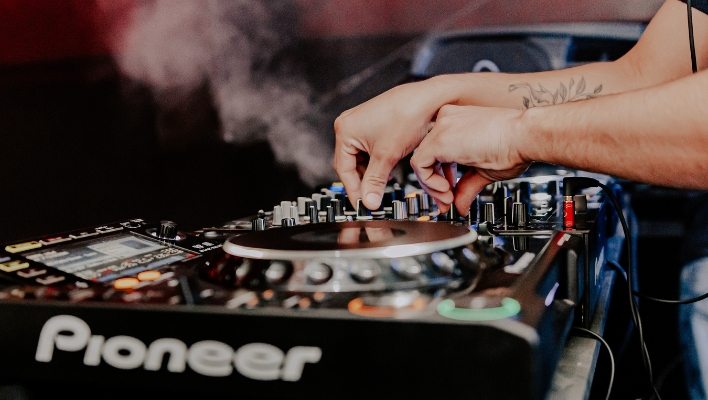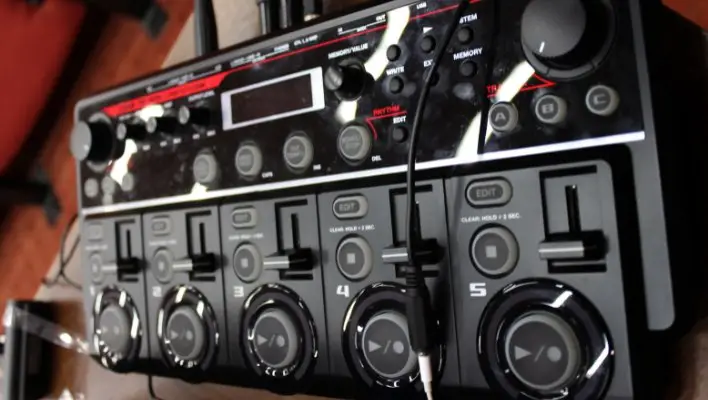If you have yet to learn about an audio mixer, you are in the right place. An audio mixer panel can look overwhelmingly complicated. For people who want to pursue careers as sound specialists in the broadcast or music industry, it is important to know how to work a mixer. In this blog, you will understand everything about an audio mixer. We will answer questions like- What does an audio mixer do? How does an audio mixer work? What is an audio mixer used for, and where is it used?
What is an Audio Mixer?
An audio mixer processes the input audio signals and outputs them into a harmonized sound. It can either be used for amplification or record a sound.
A mixer can also be called a desk, console, or board. The audio signals are input from devices like microphones, instruments, or previously recorded audio. Essentially, a mixing console mixes and balances sound.

What Does an Audio Mixer Do?
An audio mixer has many other features apart from mastering sound signals.
- It has pan control for the distribution of audio signals in a new stereo to produce stimulated sound.
- It provides phantom power to condenser microphones.
- It can be integrated with computers and other digital equipment
- It features many external sound effects you can add to your audio.

Types of Mixers
There are two major types of Mixers- Analog and Digital.
Analog
An analog mixer can only process analog signals. These mixers have no digital capacity and require the connection of a recording device. They also lack the automated recall feature of digital mixers, but the analog console has better tonal capabilities and rapid response.
Sounds processed by the analog mixers are distinctly audible in the mix. Even though sound producers have shifted to the DAW, it is common to find small analog units as a part of many home recording systems.
Digital
A digital mixer can process both analog and digital signals. Digital console has bearable latency for loudspeakers but unpleasant for in-ear monitors. The good thing is that it has plug-ins to avoid latency and simplifies the production process.
Both Analogue and Digital mixers work similarly. The only difference is the location of the controls on the panel. In an analog channel, all channels are present on the front panel and are constantly accessible. However, in a digital console, there is a single channel strip that controls various media.
Based on the channel pathways, there are two further builds of mixers: In-line and Split Monitor.
In-Line
An In-line mixer has two paths per channel. A mixer can interact with a DAW (digital audio workstation) in a two-way medium and send and receive audio through the same track.
Split Monitor
A split Monitor mixer has one path per channel. One channel can only perform one of the two functions- either receive sound from the digital audio workstation or send it that way.

What Is an Audio Mixer Used For- Applications
Primarily, an audio mixer has applications in five major areas-
- Live Events- Concerts, Nightclubs
- Recording Studios
- Audio Post-production
- Entertainment Industry and Broadcast- Television, Film, Theatre
- Public Address Systems
Components of an Audio Mixer
The working of a mixer depends on the total number of input and output channels. To learn how an audio mixer works, let us first know the different parts of an Analogue Mixing Control. These parts perform other functions and together create the output audio signal. The console comprises two major components- Channel Strips and Master Section.
1. Channel Strips
A channel strip is a control console of a single sound input. It contains functions like faders, EQ knobs, aux channels, etc., that modify the sound to control its contribution to overall audio production. There can be anywhere between 10 to 96 channels in a mixer. The choice depends on the production level and master of control over the features.
So many channel strips can overwhelm even seasoned producers, but in reality, one only needs to learn the basic commands since all channel strips are mostly the same throughout. If you understand the functions of one channel strip, you can easily control the whole panel.
A standard channel strip has the following five parts.
Aux (auxiliary)- Auxes oversee the effects and reverb blended on every channel. Another separate aux also controls the volume of the principal output channel, whether through the monitor or headphones.
Channel Faders: Every instrument has a unique control on the mix. Channel faders control the individual volume of each agency. You can create the perfect sound by adjusting the sound of each connected device individually. For example, if you have connected an electric guitar and an acoustic guitar, you can amplify the voice of the acoustic over the electric one using faders.
EQ (Equalization) knobs: EQ knobs make it possible to control the timbre of all connected instruments. Based on frequency, the sound quality can be categorized into bass, treble, and midrange. Each of these tones is adjusted by these knobs. A basic mixer would have simple controls, but an advanced mixer will have more sophisticated EQ knobs.
Buses: They route an incoming signal to another destination. The final audio goes out of the mixer through the master bus after adjusting all the controls. It is also possible to reroute a signal before it travels down to the faders using auxiliary buses. For example, in a recording studio, if you want to send the output voice to the musician, you can send it using the monitor bus before adjusting the final output quality.
Pan Pots: Pan Pots direct the audio sounds from instruments and vocals to their proper place in a stereo image field.
2. Master Section
The main section includes controls that send the processed audio to the output device. It has a master fader to control the speakers’ volume in a studio. It has volume control, effects return, and headphone jacks, among other functions. Many mixers have a 1-2 sub (second bus) that can either be used independently or send the signal back to the master output.
How Does an Audio Mixer Work?
The working of an audio mixer depends on the number of input and output channels. For instance, a 16*8 mixer means that there are sixteen input channels and eight output channels. A mixer with more channels can mix and master more audio signals.
Now. the input devices are connected to the panel through a channel strip. The mixer has an XLR input. You can choose the input device as a mic or line level.
An audio signal comes from the top of the channel strip and travels down the fader, interacting with many controls. Instruments, like electric guitars, that need a higher output require line level signal. Low-output devices like microphones connect to the mic level.
Each channel strip has an aux, fader, EQ knobs, and bus points through which the sound engineer tailors the sound. Fader controls the volume; EQ knobs manage the sound’s timbre while the buses route the signal. Similarly, each strip works with one sound.
These signals are routed to the master section as a single audio unit. If the engineer uses the 1-2 sub, the sound is merged with the main output or goes into a different channel, like the musician’s headphones. It happens without affecting the quality of the primary production.
Conclusion
An audio mixer is a dynamic production device for mixing sounds. An audio engineer can enhance the sound of any live or studio broadcast with the proper control of the console. It can take years of practice to master sound control, but new-generation audio mixers are novice-friendly and easy to operate.
